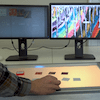INCA Project duration: July 2017 – July 2021
About
Digital content is transforming our lives. It is becoming the standard medium through which people express themselves and access vital goods and services. However, many people struggle to engage with digital content. This includes people with aphasia, a language disorder most commonly caused by a stroke.
Aphasia, which affects 350,000 people in the UK, can affect people’s ability to speak, to understand speech, to read and to write. In severe cases, people may be able to speak only a few words or may have very limited ability to read and write.
Project Objectives
The INCA project is addressing the issue of exclusion of people with language impairments, specifically acquired aphasia, from digital content creation and consumption. The overall objective is to investigate, co-design and trial digital content creation and curation tools for people with aphasia; specific sub-objectives are:
- To investigate and create innovative prototype digital technologies that empower people with aphasia to become content creators, curators and consumers.
- To evaluate the accessibility, acceptability and usability of the technologies through community projects where groups of people with aphasia work together over extended periods of time to create and curate digital content.
- To assess the impact of using the technologies on people’s sense of well-being, social inclusion and technology use.
- To deliver digital content from the community projects that give people with aphasia an online digital presence.
- To develop co-design techniques that support the participation of people with aphasia in design.
- To contribute to interaction and content design guidelines for people with aphasia.
Project Activities
Part 1: Understanding the Context
 The initial stages of the project explored the needs, skills and desires of people with aphasia with regard to digital content creation and curation. This involved usability and accessibility testing of existing tools, interviews and a systematic literature review.
The initial stages of the project explored the needs, skills and desires of people with aphasia with regard to digital content creation and curation. This involved usability and accessibility testing of existing tools, interviews and a systematic literature review.
Part 2: A Tool for People with Mild to Moderate Aphasia
 A series of six co-design workshops explored the design of a content creation and curation technology for people with mild to moderate aphasia. This led to the idea of computer-supported constrained creativity. We developed the MakeWrite tool which uses this approach. The same idea was then used in the Comic Spin app.
A series of six co-design workshops explored the design of a content creation and curation technology for people with mild to moderate aphasia. This led to the idea of computer-supported constrained creativity. We developed the MakeWrite tool which uses this approach. The same idea was then used in the Comic Spin app.
Part 3: A Tool for People with Severe Aphasia
 A second series of co-design workshops explored content creation and curation for people with more severe aphasia. We focused on investigating blended and tangible technologies, merging the physical and digital worlds, where users interact via a range of physical and digital devices to create and refashion content. We developed the CreaTable tangible device.
A second series of co-design workshops explored content creation and curation for people with more severe aphasia. We focused on investigating blended and tangible technologies, merging the physical and digital worlds, where users interact via a range of physical and digital devices to create and refashion content. We developed the CreaTable tangible device.
Part 4: Evaluation and Community Projects
 The prototype technologies have been explored and evaluated in two community projects delivered in collaboration with Dyscover, and facilitated by a visual artist in residence.
The prototype technologies have been explored and evaluated in two community projects delivered in collaboration with Dyscover, and facilitated by a visual artist in residence.
